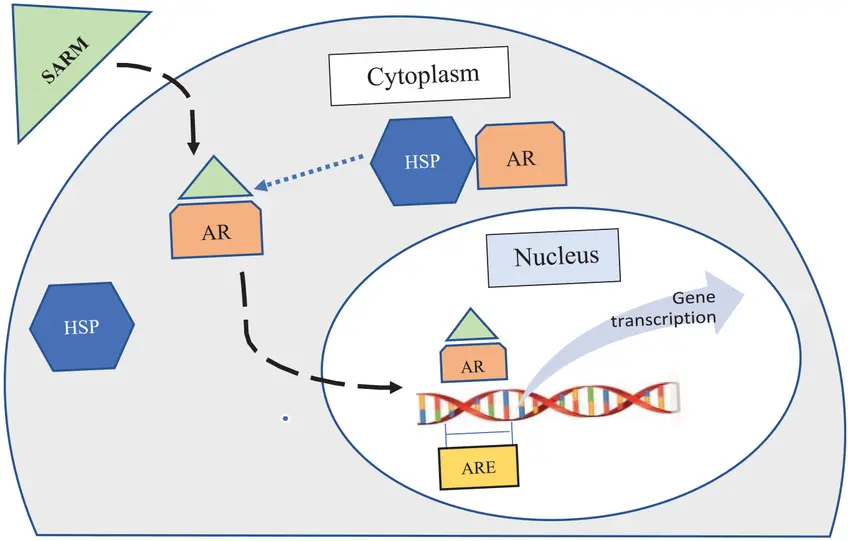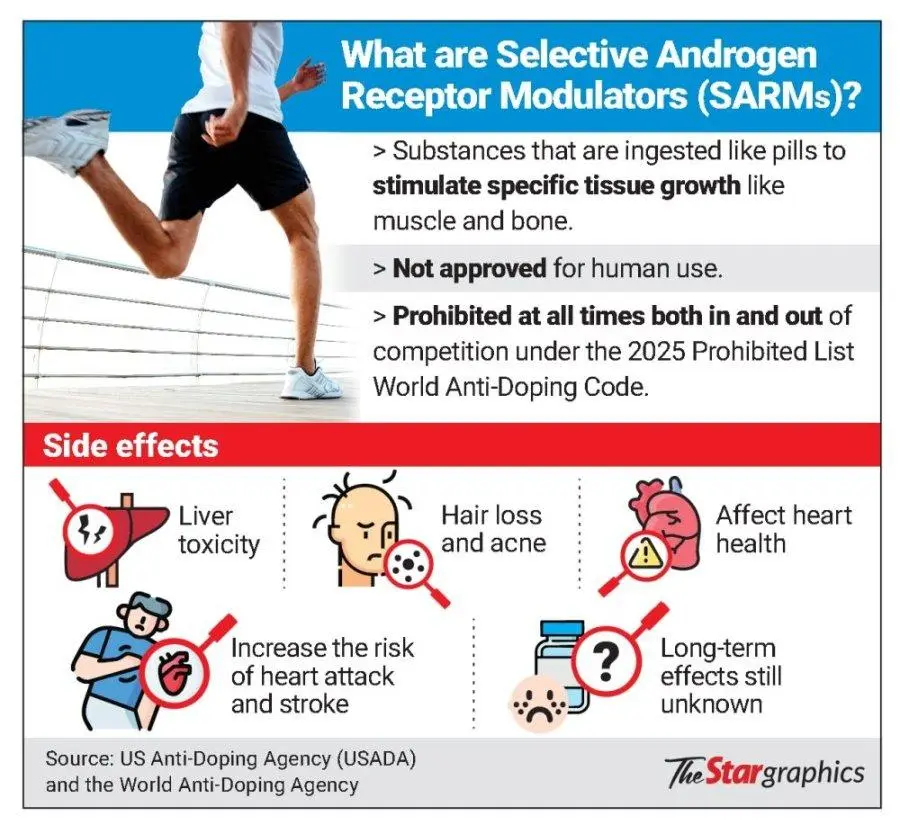RAD 140 (Testolone): Truth Bodybuilders Need to Know

In the ever-evolving world of performance enhancement, few compounds have generated as much buzz in recent years as RAD 140, commonly known as Testolone or Vosilasarm. This powerful compound belongs to a class of substances called Selective Androgen Receptor Modulators (SARMs), which have gained significant popularity in bodybuilding and fitness communities.
RAD 140 was originally developed by Radius Health, Inc. for potentially treating muscle wasting conditions and breast cancer. Its initial research purpose was to provide targeted anabolic effects without the full spectrum of androgenic side effects associated with traditional anabolic steroids—an appealing proposition for both medical applications and performance enhancement.
However, it’s crucial to understand RAD 140’s current status: it remains an investigational drug not approved by the FDA for human use. Additionally, it appears on the World Anti-Doping Agency’s (WADA) list of prohibited substances, making it banned in competitive sports.
This article aims to provide a comprehensive, evidence-based examination of RAD 140 specifically for bodybuilders and fitness enthusiasts. We’ll explore its mechanisms, potential benefits, documented risks (with special emphasis on liver toxicity), dosage considerations, and what you should know about reported results—all with a focus on helping you make an informed decision.
The Science: How is RAD 140 Supposed to Work?

Primary Mechanism: Selective Androgen Receptor Binding
The core function of RAD 140, like other SARMs, involves its interaction with androgen receptors (ARs) throughout the body. What makes SARMs theoretically advantageous is their “selective” nature—they’re designed to primarily target ARs in muscle and bone tissue while having reduced activity in other tissues such as the prostate and sebaceous glands.
RAD 140 exhibits a particularly high binding affinity for androgen receptors, which is why it’s often described as one of the more potent SARMs available. When it binds to these receptors, it triggers many of the same anabolic pathways that testosterone activates, potentially stimulating protein synthesis, nitrogen retention, and overall muscle growth.
Lack of Aromatization/5α-Reduction
Unlike testosterone, RAD 140 is not supposed to convert to estrogen through aromatization or to dihydrotestosterone (DHT) via 5α-reductase enzyme activity. In theory, this should reduce certain side effects commonly associated with anabolic steroids, such as gynecomastia (male breast development), excessive water retention, and accelerated hair loss.
However, it’s important to note that “selectivity” isn’t absolute. While SARMs like RAD 140 demonstrate preferential activity in certain tissues, they still affect androgen receptors throughout the body to varying degrees. This explains why users still report androgenic side effects despite the theoretical selectivity.
Potential RAD 140 Benefits Claimed for Bodybuilding
Many bodybuilders and fitness enthusiasts turn to RAD 140 based on reports of several potential benefits:

Increased Lean Muscle Mass
The primary attraction of RAD 140 is its reputation for promoting significant lean muscle growth. Through potent anabolic signaling in muscle tissue, users often report substantial gains in muscle size and density, particularly when combined with appropriate training and nutrition.
Enhanced Strength and Power Output
Closely related to muscle development, RAD 140 has been associated with notable increases in strength and power. This could potentially allow for more intensive training sessions and progressive overload—key factors in stimulating further muscle growth.
Potential Bone Health Improvement
Research suggests that RAD 140 may interact with androgen receptors in bone tissue, potentially enhancing bone mineral density and strength. This aspect was among the original research interests, though human data specifically examining this effect remains limited.
Potential Neuroprotective Effects? (Early Research Context)
Some preliminary preclinical research has suggested possible neuroprotective properties of RAD 140. This is often cited in discussions about the compound, though it’s important to emphasize that this research is in very early stages, lacks human verification, and has little relevance to bodybuilding applications.
Important Disclaimer: These potential benefits are largely based on preclinical data (laboratory and animal studies), theoretical mechanisms of action, and anecdotal user reports—not from robust human clinical trials specifically examining bodybuilding applications. The actual risk-benefit profile in humans remains poorly characterized.
RAD 140 Side Effects: Documented Risks and Dangers
While the potential benefits may sound appealing, RAD 140 is associated with several significant health risks that must be seriously considered:

Severe Liver Toxicity (Hepatotoxicity) – CRITICAL RISK
WARNING: DOCUMENTED LIVER DAMAGE
Multiple medical case reports have linked RAD 140 use to severe drug-induced liver injury (DILI), even with short-term use at typical bodybuilding doses. This represents one of the most serious risks associated with RAD 140.
Recent medical literature has documented several cases of severe liver injury directly attributed to RAD 140 use. These aren’t merely theoretical concerns but documented medical emergencies requiring hospitalization. The liver damage associated with RAD 140 is often characterized as cholestatic, meaning it impairs the flow of bile from the liver.
Symptoms of RAD 140-induced liver injury include:
- Jaundice (yellowing of skin and eyes)
- Dark urine
- Light-colored stools
- Abdominal pain
- Extreme fatigue
- Nausea and vomiting
- Itching
What’s particularly concerning is that these cases occurred even with relatively short cycles (4-8 weeks) and at doses commonly recommended in bodybuilding communities (10-20mg daily). In some cases, patients required extensive medical intervention, and the potential for permanent liver damage or even liver failure exists with severe cases.
Testosterone Suppression
RAD 140 significantly suppresses natural testosterone production through negative feedback on the hypothalamic-pituitary-testicular axis. Despite claims of mild suppression, many users experience substantial decreases in endogenous testosterone, which can lead to:
- Loss of libido
- Fatigue and lethargy
- Mood disturbances
- Loss of muscle gains after cycle completion
- Potential long-term endocrine disruption
This suppression necessitates a Post-Cycle Therapy (PCT) protocol to help restore natural hormone production, though recovery can be prolonged and sometimes incomplete.
Negative Impacts on Health Markers (Animal Study Evidence)
Concerning research in animal models contradicts some of the claimed benefits of RAD 140. A notable study published on PubMed examined the effects of long-term RAD 140 administration in female mice. Rather than improving physical performance, the study found:
- Decreased muscle adaptation to exercise
- Increased frailty
- Higher mortality risk
While animal studies don’t always translate directly to humans, these findings raise serious questions about the long-term health implications of RAD 140 use.
Potential Cardiovascular Strain
RAD 140 can negatively impact lipid profiles, typically decreasing HDL (“good” cholesterol) and potentially increasing LDL (“bad” cholesterol). These changes may increase cardiovascular risk, especially with prolonged use or in individuals with pre-existing cardiac risk factors.
Androgenic Side Effects (Despite Selectivity Claims)
Despite the theoretical selectivity, RAD 140 users frequently report androgenic side effects, including:
- Hair shedding/accelerated male pattern baldness
- Acne and oily skin
- Aggression and mood swings
- Voice changes (particularly concerning for female users)
These effects tend to increase with higher dosages, longer cycles, and individual susceptibility.
Other Reported Issues
Additional side effects reported by users and noted in preliminary clinical investigations include:
- Nausea and digestive disturbances
- Headaches
- Sleep disturbances
- Lethargy and fatigue
- Vomiting and dehydration (noted in early clinical trials)
- Elevated blood pressure
Unknown Long-Term Consequences
Perhaps most concerning is what we don’t know. With no long-term human studies examining the safety profile of RAD 140, especially in the context of bodybuilding usage patterns, the potential for currently unidentified long-term health consequences remains a significant risk.
RAD 140 Dosage: High Risk, No Guidelines
There are NO medically approved or established safe dosages for RAD 140 in humans for bodybuilding or any other purpose.
In bodybuilding communities, typical dosage recommendations range from 10mg to 30mg daily, with cycle lengths usually between 6 to 8 weeks. However, these dosages:
- Have no scientific validation for safety or efficacy
- Are based entirely on anecdotal reports and forum discussions
- Have been directly linked to severe adverse effects, including liver injury
Medical case reports have documented severe liver damage occurring at doses as low as 15mg per day for just a few weeks of use. The compound’s long half-life (approximately 60 hours) means it accumulates in the system over time, potentially increasing risk with sustained use.
No “sweet spot” exists where benefits are guaranteed without risks. Any use of RAD 140, regardless of dosage, carries significant health concerns due to its uninvestigated status in humans and documented adverse effects.
RAD 140 Before and After: Separating Hype from Reality
The internet abounds with dramatic “transformation” photos and claims attributed to RAD 140. While some users undoubtedly experience physique changes while using this compound, several important factors must be considered when evaluating these claims:
Why Anecdotal Results Are Unreliable
- Multiple Variables: Most users reporting significant results are simultaneously implementing multiple factors known to enhance physique and performance—optimized nutrition, progressive training programs, adequate recovery, and sometimes multiple performance-enhancing substances.
- Selection Bias: Those experiencing dramatic positive results are far more likely to share their experiences than those with minimal results or negative outcomes, creating a distorted picture of typical outcomes.
- Documentation Issues: Before/after photos often involve differences in lighting, posing, pump status, hydration, and sometimes even editing or filters, exaggerating apparent results.
- Incomplete Health Picture: Visible physique changes reveal nothing about internal health impacts. Someone might look impressive while experiencing serious liver damage, hormonal disruption, or other health complications.
- Potential Misattribution: Some “RAD 140” products may contain different compounds entirely or be contaminated with other substances that could contribute to observed effects (positive or negative).
The Scientific Reality
In stark contrast to anecdotal claims, the scientific literature on RAD 140 for bodybuilding purposes reveals:
- No verified human clinical data supporting efficacy for muscle building
- Multiple documented cases of severe adverse health effects, particularly liver toxicity
- Animal studies showing potential negative long-term health impacts
When evaluating claims about RAD 140, it’s essential to prioritize documented medical evidence of risks over unverified anecdotal reports of benefits.
Legality, Availability, and Purity Risks
RAD 140 occupies a legal gray area in many countries. It is:
- Not FDA-approved for human use
- Often sold labeled “for research purposes only”
- Banned by WADA and most major sports organizations
- Subject to various legal restrictions depending on jurisdiction
This status creates significant concerns regarding product quality and safety:
- No pharmaceutical-grade standards or regulations exist for products sold online
- Risk of contamination with heavy metals, other drugs, or toxic substances
- Actual content may differ significantly from labeled amounts
- Complete substitution with different compounds is not uncommon
These factors add additional layers of risk beyond the inherent dangers of the compound itself.
Conclusion: RAD 140 – A High-Risk Gamble
After examining the available evidence surrounding RAD 140, several key points emerge:
- RAD 140 is a potent SARM with theoretical muscle-building potential based on its mechanism of action.
- Multiple documented medical cases link RAD 140 to severe liver toxicity, even with short-term use at common bodybuilding doses.
- Animal studies suggest potential negative long-term health outcomes rather than benefits.
- No established safe dosage exists, and the compound lacks FDA approval or comprehensive human safety data.
- The visible benefits seen in anecdotal reports must be weighed against documented health risks and the unknown long-term consequences.
The conclusion is clear: the potential risks associated with RAD 140—especially severe liver damage—substantially outweigh any unproven benefits for bodybuilding. The existing medical literature strongly suggests that this compound poses serious health hazards that cannot be justified by theoretical or anecdotal performance enhancement.
For those seeking to improve their physique and performance, numerous evidence-based approaches exist that don’t carry these significant health risks. Consulting with healthcare professionals, sports nutritionists, and certified strength coaches can help develop effective strategies for reaching your fitness goals safely and sustainably.
Resources & Further Reading
Liver Injury Case Reports:
- Severe liver injury following use of RAD-140… (PMC): https://www.ncbi.nlm.nih.gov/pmc/articles/PMC10911832/
- RAD-140 Drug-Induced Liver Injury (Ochsner Journal / PMC): https://www.ncbi.nlm.nih.gov/pmc/articles/PMC9753945/
- Animal Study on Long-Term Effects:
- RAD140 (Testolone) negatively impacts skeletal muscle adaptation… (PubMed Abstract): https://pubmed.ncbi.nlm.nih.gov/37758180/
- General Information & Regulatory Status:
- Vosilasarm (RAD140) – Wikipedia: https://en.wikipedia.org/wiki/Vosilasarm (Use as a starting point, be aware it’s user-editable)
- World Anti-Doping Agency (WADA) Prohibited List: https://www.wada-ama.org/en/prohibited-list (Search for SARMs or RAD140 under S1.2)
- FDA Warnings on SARMs:
- FDA Warning Letters and Safety Information (Search FDA website for “SARMs”): https://www.fda.gov/ (General resource, specific warnings may exist)
